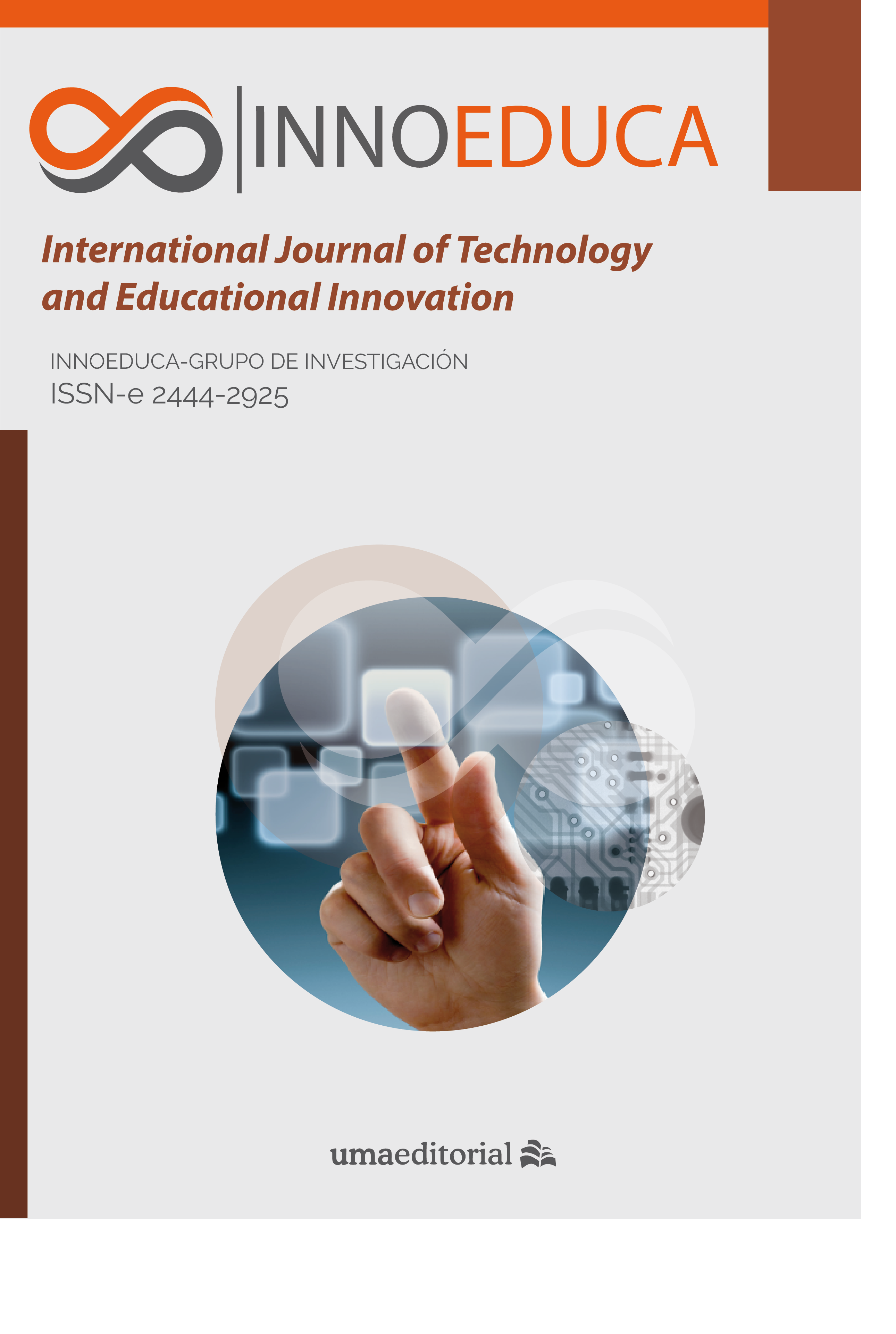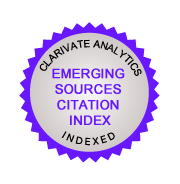Educommunication in digital environments: an interaction´s perspective inside and beyond the classroom
DOI:
https://doi.org/10.24310/innoeduca.2020.v6i1.4959Keywords:
computer-assisted learning, open education, interaction, information and communication technologies, learning environmentAbstract
In a highly interconnected and technology-mediated world, the way in which education is recognized as a communicative phenomenon is highly relevant to understand its development and future possibilities. In this text, educommunication is analyzed from the point of view of interactions that occur in different digital learning environments, especially in ICT-enhanced classrooms, blended learning, e-learning, mobile learning and Massive Open Online Courses (MOOC). This analysis was conducted from a systematic literature review of 240 papers that describe research generated on these topics, during the last 20 years.
The results show that beyond the importance of interaction for the development of educational practices, different digital environments involve different ways of conceiving and deploying interaction processes, inside and outside the classroom.
This implies the imperative need to adjust the current processes of teacher training in such a way that teachers can understand these differences and recognize both their theoretical and practical implication.Downloads
Metrics
References
Almenara, J. C., Del Carmen Llorente Cejudo, M., & Martínez, A. I. V. (2014). MOOC’s typologies: Design and educational implications [Las tipologías de mooc: Su diseño e implicaciones educativas]. Profesorado, 18(1), 13–26. Retrieved from https://www.scopus.com/inward/record.uri?eid=2-s2.0-84903777480&partnerID=40&md5=899b53179e524eb8fc59ee75ab6da888
Alraimi, K. M., Zo, H., & Ciganek, A. P. (2015). Understanding the MOOCs continuance: The role of openness and reputation. Computers & Education, 80, 28–38. https://doi.org/10.1016/j.compedu.2014.08.006
Bartolomé, A. (2004). Blended learning. Conceptos básicos. Píxel-Bit. Revista de Medios y Educación, 23, 7–20.
Cánepa, G., & Ardèvol, E. (2014). Diversidad cultural, visualidades y tecnologías digitales. Anthropologica Del Departamento de Ciencias Sociales, 32(33), 5–9. Retrieved from http://www.redalyc.org/pdf/886/88636924001.pdf
Castro-Rodríguez, Y., & Lara-Verástegui, R. (2017). Percepción del blended learning en el proceso enseñanza aprendizaje por estudiantes del posgrado de Odontología. Educación Médica, 1–6. https://doi.org/10.1016/j.edumed.2017.03.028
Chiappe, A., & Arias, V. (2016). La Educomunicación en entornos digitales: un análisis desde los intercambios de información. Opción, 32(7), 461–479. Retrieved from http://produccioncientificaluz.org/index.php/opcion/article/view/21486
de Waard, I., Koutropoulos, A., Hogue, R. J., Abajian, S. C., Keskin, N. Ö., Rodriguez, C. O., & Gallagher, M. S. (2012). Merging MOOC and mLearning for Increased Learner Interactions: International Journal of Mobile and Blended Learning, 4(4), 34–46. https://doi.org/10.4018/jmbl.2012100103
Ersoy-Babula, A. I., & Babula, M. (2018). Learning on the move business students’ adaptation of virtual learning environment and mobile device technology. The International Journal of Management Education, 16(2), 321–326. https://doi.org/10.1016/j.ijme.2018.04.007
Fernández-Cárdenas, J. M. (2013). El habla en interacción y la calidad educativa: los retos de la construcción de conocimiento disciplinar en ambientes mediados por tecnología digital. Revista Mexicana de Investigación Educativa, 18(56), 223–248.
Fidalgo-Blanco, Á., Sein-Echaluce, M. L., & García-Peñalvo, F. J. (2016). From massive access to cooperation: lessons learned and proven results of a hybrid xMOOC/cMOOC pedagogical approach to MOOCs. International Journal of Educational Technology in Higher Education, 13(1). https://doi.org/10.1186/s41239-016-0024-z
Figueira, A. (2009). Mapping e-learning interactions using social network analysis. In Proceedings of the 8th IASTED International Conference on Web-based Education, WBE 2009 (pp. 66–72). Phuket; Thailand: IASTED. Retrieved from https://www.scopus.com/inward/record.uri?eid=2-s2.0-74549205229&partnerID=40&md5=a6e2ef6e77021613be279385a9557d8e
Géczy, P. (2009). Human behavior and interactions in web environments. In ICEIS 2009 - 11th International Conference on Enterprise Information Systems, Proceedings (Vol. DISI, p. IS-5-IS-6). Retrieved from https://www.scopus.com/inward/record.uri?eid=2-s2.0-74549191075&partnerID=40&md5=491b2ce9a3239d630bbf9ede7220c60b
Gholizadeh, M., Taghiyareh, F., & Alvandkoohi, S. (2018). Toward a Propensity-Oriented Player Typology in Educational Mobile Games: International Journal of Game-Based Learning, 8(2), 55–67. https://doi.org/10.4018/IJGBL.2018040105
Gregory, A. T., & Denniss, A. R. (2018). An Introduction to Writing Narrative and Systematic Reviews — Tasks, Tips and Traps for Aspiring Authors. Heart, Lung and Circulation, 27(7), 893–898. https://doi.org/10.1016/j.hlc.2018.03.027
Gunga, S. O., & Ricketts, I. W. (2008). The Prospects for E?Learning Revolution in Education: A philosophical analysis. Educational Philosophy and Theory, 40(2), 294–314. https://doi.org/10.1111/j.1469-5812.2007.00332.x
Hanzu-Pazara, R., & Barsan, E. (2010). Teaching techniques - Modern bridges between lecturers and students. In International Conference on Engineering Education and International Conference on Education and Educational Technologies - Proceedings (pp. 176–181). Retrieved from https://www.scopus.com/inward/record.uri?eid=2-s2.0-79958747098&partnerID=40&md5=aaa782301541043ac573c256c8384845
Hijón-Neira, R., Velázquez-Iturbide, J. Á., Barn, B., & Oussena, S. (2008). A Comparative Study on the Analysis of Students Interactions in e-Learning (pp. 20–22). IEEE. https://doi.org/10.1109/ICALT.2008.282
Hone, K. S., & El Said, G. R. (2016). Exploring the factors affecting MOOC retention: A survey study. Computers & Education, 98, 157–168. https://doi.org/10.1016/j.compedu.2016.03.016
Jeffrey, B., & Craft, A. (2004). Teaching creatively and teaching for creativity: distinctions and relationships. Educational Studies, 30(1), 77–87. https://doi.org/10.1080/0305569032000159750
Kazi, S. A. (2007). MILE: Mobile intelligent learning environment - A conceptual framework for mLearning. International Journal of Engineering Education, 23(3), 468–473. Retrieved from https://www.scopus.com/inward/record.uri?eid=2-s2.0-34547195757&partnerID=40&md5=97fb954c8a422b8ba53ec467b05217e3
Li, K. C., Lee, L. Y.-K., Wong, S.-L., Yau, I. S.-Y., & Wong, B. T.-M. (2018). Effects of mobile apps for nursing students: learning motivation, social interaction and study performance. Open Learning: The Journal of Open, Distance and e-Learning, 33(2), 99–114. https://doi.org/10.1080/02680513.2018.1454832
Lobel, M., Neubauer, M., & Swedburg, R. (2005). Comparing How Students Collaborate to Learn About the Self and Relationships in a Real-Time Non-Turn-Taking Online and Turn-Taking Face-to-Face Environment. Journal of Computer-Mediated Communication, 10(4), 00–00. https://doi.org/10.1111/j.1083-6101.2005.tb00281.x
Lorenzo, A. R. (2017). Comparative study on the performance of bachelor of secondary education (BSE) students in educational technology using blended learning strategy and traditional face-to-face instruction. Turkish Online Journal of Educational Technology, 16(3), 36–46. Retrieved from https://www.scopus.com/inward/record.uri?eid=2-s2.0-85025070933&partnerID=40&md5=7b0837cb89a462e5341aaf77844bc021
Margaryan, A., Bianco, M., & Littlejohn, A. (2015). Instructional quality of Massive Open Online Courses (MOOCs). Computers & Education, 80, 77–83. https://doi.org/10.1016/j.compedu.2014.08.005
Mariño, J. C. G. (2006). B-Learning utilizando software libre, una alternativa viable en Educación Superior. Revista Complutense de Educación, 17(1), 121.
Mohamed, M. H., & Hammond, M. (2018). MOOCs: a differentiation by pedagogy, content and assessment. International Journal of Information and Learning Technology, 35(1), 2–11. https://doi.org/10.1108/IJILT-07-2017-0062
Molinillo, S., Aguilar-Illescas, R., Anaya-Sánchez, R., & Vallespín-Arán, M. (2018). Exploring the impacts of interactions, social presence and emotional engagement on active collaborative learning in a social web-based environment. Computers & Education, 123, 41–52. https://doi.org/10.1016/j.compedu.2018.04.012
Montepare, J. M. (2014). Nonverbal Behavior in the Digital Age: Meanings, Models, and Methods. Journal of Nonverbal Behavior, 38(3), 279–281. https://doi.org/10.1007/s10919-014-0187-z
Morán, L. (2012). Blended–learning. Desafío y oportunidad para la educación actual. EDUTEC, Revista Electrónica de Tecnología Educativa, 39. Retrieved from http://edutec.rediris.es/Revelec2/Revelec39/pdf/Edutec-e_39_%20Moran.pdf
Perez Pinal, F., Nava, S., Nunez Perez, J., Araujo Vargas, I., Vera Cardenas, E., & Barranco Gutierrez, A. (2016). Experimental B-learning laboratory for an electrical machines undergraduate course. IEEE Latin America Transactions, 14(2), 524–529. https://doi.org/10.1109/TLA.2016.7437188
Quesada, M., & Solernou, I. A. (2013). Acercamiento al estudio de la comunicación educativa en una facultad universitaria en salud. Educación Médica Superior, 27(4), 366–373.
Riley, J. M., Ellegood, W. A., Solomon, S., & Baker, J. (2017). How mode of delivery affects comprehension of an operations management simulation: Online vs face-to-face classrooms. Journal of International Education in Business, 10(2), 183–200. https://doi.org/10.1108/JIEB-09-2016-0025
Salas, A., & Pírela, J. L. (2010). Diseño de una metodología de gestión del conocimiento para la educación a distancia sustentada en el enfoque B-Learning. In 1 jornadas internacionales de educación a distancia (pp. 1–6). Zulia: Universidad del Zulia. Retrieved from http://sed.luz.edu.ve/jornadas/wp-content/uploads/Dise%C3%83%C2%B1o-de-una-Metodolog%C3%83%C2%ADa-de-Gesti%C3%83%C2%B3n_A_Salas.pdf
Shu, H., & Gu, X. (2018). Determining the differences between online and face-to-face student–group interactions in a blended learning course. The Internet and Higher Education, 39, 13–21. https://doi.org/10.1016/j.iheduc.2018.05.003
Shu, H., Wei, Y., & Gu, X.-Q. (2017). Is There Difference between In and Out of Classroom? Harnessing the Group Interaction of Blended Learning (pp. 186–188). Timisoara, Romania: IEEE. https://doi.org/10.1109/ICALT.2017.159
Smith, B., & Eng, M. (2013). MOOCs: A Learning Journey. In S. K. S. Cheung, J. Fong, W. Fong, F. L. Wang, & L. F. Kwok (Eds.), Hybrid Learning and Continuing Education (Vol. 8038, pp. 244–255). Berlin, Heidelberg: Springer Berlin Heidelberg. https://doi.org/10.1007/978-3-642-39750-9_23
Stanton, W. W., & Stanton, A. D. (2017). Traditional and Online Learning in Executive Education: How Both Will Survive and Thrive: Traditional and Online Learning in Executive Education. Decision Sciences Journal of Innovative Education, 15(1), 8–24. https://doi.org/10.1111/dsji.12119
Sunar, A. S., White, S., Abdullah, N. A., & Davis, H. C. (2017). How Learners’ Interactions Sustain Engagement: A MOOC Case Study. IEEE Transactions on Learning Technologies, 10(4), 475–487. https://doi.org/10.1109/TLT.2016.2633268
Tovar, N. (2013). La educomunicación en la universidad virtual: retos del modelo/Educommunication in the Virtual University: Challenges of the model. Estudios Sobre El Mensaje Periodístico, 19, 491–499. Retrieved from http://revistas.ucm.es/index.php/esmp/article/download/42135/40114
Troussas, C., Krouska, A., & Virvou, M. (2017). Social interaction through a mobile instant messaging application using geographic location for blended collaborative learning (pp. 1–5). IEEE. https://doi.org/10.1109/IISA.2017.8316395
Velázquez Sortino, M., Gómez-Zermeño, M. G., & Alemán De La Garza, L. (2017). Interactions in a massive, online, open course (MOOC) for teacher’s. Proposal for a model of analysis [Interacciones en un curso en línea, abierto y masivo para docentes. Propuesta para un modelo de análisis]. Digital Education Review, (31), 149–175. Retrieved from https://www.scopus.com/inward/record.uri?eid=2-s2.0-85045613891&partnerID=40&md5=d5c918fdd88253065b9bf94e52c94360
Wang, M., & Shen, R. (2012). Message design for mobile learning: Learning theories, human cognition and design principles: Message design for mobile learning. British Journal of Educational Technology, 43(4), 561–575. https://doi.org/10.1111/j.1467-8535.2011.01214.x
Watson, S., & Sutton, J. M. (2012). An examination of the effectiveness of case method teaching online: Does the technology matter? Journal of Management Education, 36(6), 802–821. Retrieved from http://citeseerx.ist.psu.edu/viewdoc/download?doi=10.1.1.891.2681&rep=rep1&type=pdf
Wise, A. F., & Cui, Y. (2018). Learning communities in the crowd: Characteristics of content related interactions and social relationships in MOOC discussion forums. Computers & Education, 122, 221–242. https://doi.org/10.1016/j.compedu.2018.03.021
Yengin, I., Karahoca, A., & Karahoca, D. (2011). E-learning success model for instructors’ satisfactions in perspective of interaction and usability outcomes. Procedia Computer Science, 3, 1396–1403. https://doi.org/10.1016/j.procs.2011.01.021
Zou, B., & Thomas, M. (Eds.). (2018). Handbook of Research on Integrating Technology Into Contemporary Language Learning and Teaching: IGI Global. https://doi.org/10.4018/978-1-5225-5140-9
Downloads
Published
How to Cite
Issue
Section
License
All contents published by Innoeduca. International Journal of Technology and Educational Innovation are subject to Creative Commons Attribution-Nocomercial-NoDerivatives 4.0 International License, whose complete text can be consulted at https://creativecommons.org/licenses/by-nc-nd/4.0/legalcode. Thus, copying, distribution, public communication, derivative works and commercial use of content are permitted as of the aforementioned issue provided that the source and the author of the text are cited.
It is the responsibility of the authors to obtain the necessary permits for images that are subject to copyright.

This work is licensed under a Creative Commons Attribution-NonCommercial-NoDerivatives 4.0 International License.









1.jpg)



242.png)








